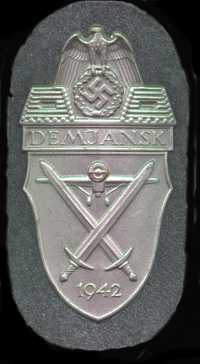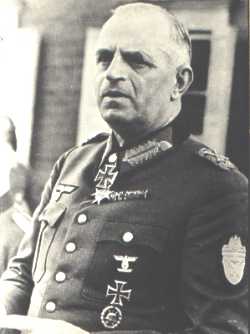
By Sebastián Bianchi
The Demjansk Shield was instituted on April 25th, 1943, to commemorate those troops who fought in the Demjansk pocket during 1942.
Shield Properties
| The center top the shield has an eagle with down
spread wings clutching a wreath that surrounds swastika. On each
side of the swastika there are two pillboxes of a trapezoid shape with a
gun opening in the center. Below then is a box with word “DEMJANSK” in
capital letters.
The main body of the shield has undulated sides, with its main design being a single engine reconnaissance aircraft and two crossed, large military swords. Two variations of the aircrafts’ propeller exist, as some shield shields show it curved while others show it straight. Located below the swords is the year “1942”. The shield was die struck and produced in silver washed zinc and later in plain zinc. It was affixed to the uniform via a cloth that matched the color of the uniform of the recipient. |
 |
The Demjansk Pocket
On February 8th 1942, the Russians encircled the 2nd Army Corp in the small town of Demjansk, located in the northern section of the Russian front about 100 miles north-east of Cholm. Trapped in the pocket were the 12th, 30th, 32nd, 223rd and 290th Heer Infantry Divisions, as well as the 3rd SS “Totenkopf” Division. There were also RAD, Police, Todt organization, and other auxiliary units who were trapped and assisted in the battle. Their commander was General der Infanterie Graf Brockdordd-Ahlefeldt.
Ordered to resist, the garrison was extensively and appropriately supplied by the Luftwaffe. During their besiegement the group offered the Russians stiff and determined resistance, tying up three Soviet Armies (composed of 18 Infantry Divisions and three brigades) for the length of 14 months. The battle group was able to break out of the siege on the 21st of April, but the battle had taken a toll. Out of the approximately 100,000 men trapped there were 3,335 never returned, and over 10,000 were wounded. However, their heroic struggle had denied the Soviet High Command of numerous units at a critical moment, units that would have otherwise been used elsewhere in the Eastern front.
Even thought they were no longer trapped, fighting in the area continued until October of 1942. For his excellence in command in the particularly fierce fighting of his elite unit, Totenkopf commander SS Obergruppenfuhrer und General der Waffen SS Theodor Eike was awarded the Oak Leaves to the Knights Cross (88th) on May 20th, 1942.
Award Criteria, Statistics and Wear
The garrison commander presented the shield to members of the Wehrmacht and auxiliary units in good standing who meet the following criteria,
|
Heer/Auxiliary Luftwaffe Company commanders were responsible for reporting the list of eligible men under their command by December 31, 1943. The award ceased to be presented on July 4th, 1944. Each recipient was entitled to five copies of the shield, and in case of death, a single shield and an entitlement certificate was presented to the next of kin. The shield was to be worn on the upper sleeve of the uniform (example to the right- General Field-Marschall Ferdinand Busch). In the case of the Waffen SS, it is worthy of note that it was to be worn above the SS arm eagle. It is estimated that over 100,000 shields were presented. |
 |
![]()
© Copyright Wehrmacht-Awards.com LLC |